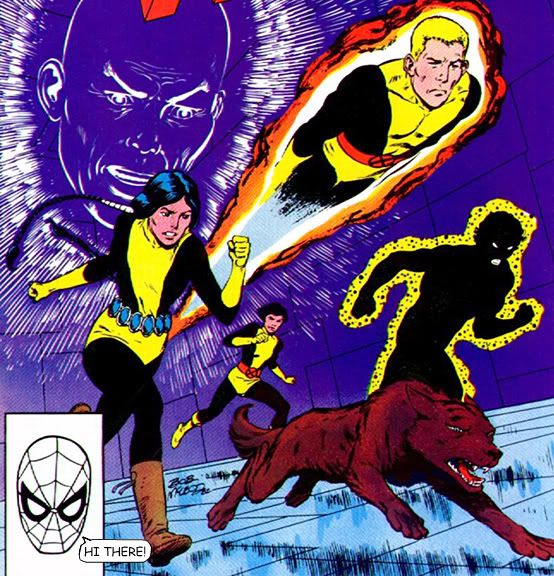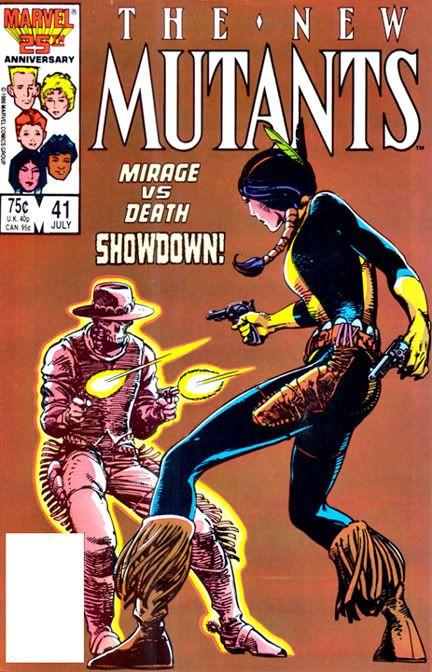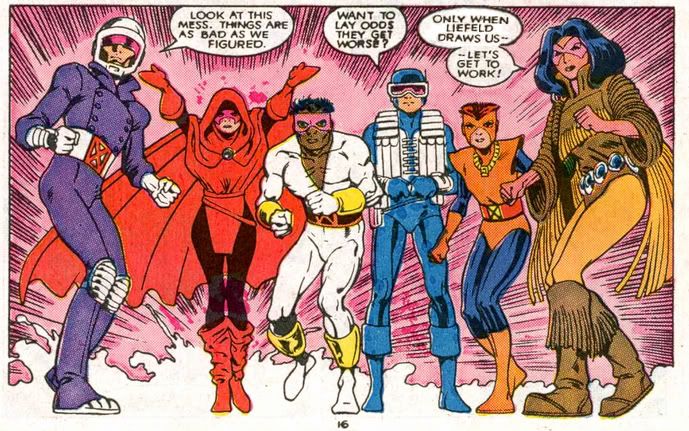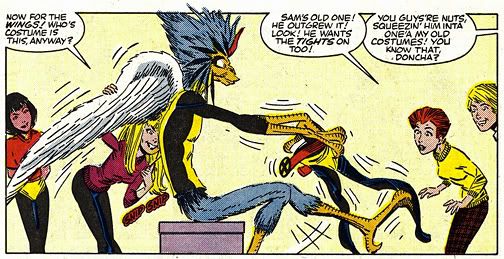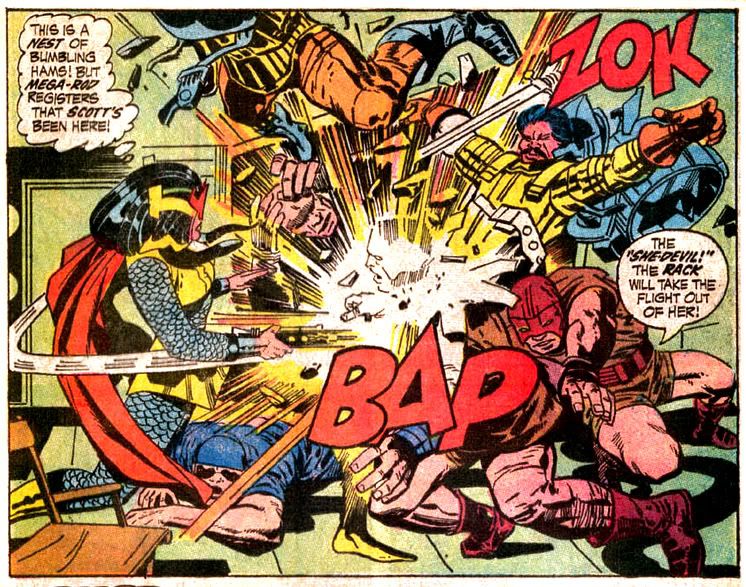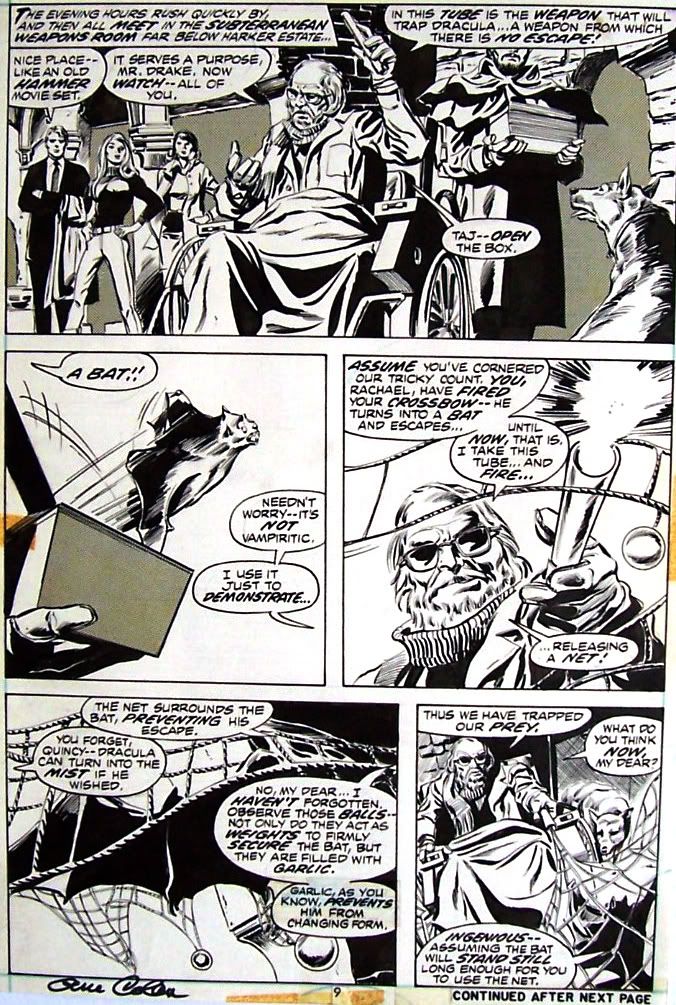When we first meet Dani Moonstar in Marvel Graphic Novel 4: New Mutants, she's a rough around the edges tomboy who enjoys romping in the mountains with her mountain lion friends. And occasionally threatening to plunge Black Eagle's war-knife into craven hearts.
And she has a good reason: the guy in the magenta armor killed her grandfather, the afore-mentioned Black Eagle. But notice how she demonstrates her nascent team leadership skills-- she prefaces her threat with the phrase, "If you've no more need of this butcher --" That's right, like all great leaders, Dani is nothing if not pragmatic. Under normal circumstances, Dani would certainly stab the man's "craven heart," but if the Professor and her newfound friend Rahne object from a continued butcher utilitarian standpoint, she'll defer to their wishes.
Because she's cool like that.
Soon enough, Dani and Rahne make the journey to the X-Mansion in Westchester, New York and join Charles Xavier's new team of super-powered teens, the New Mutants. And it's in their company that Dani begins to explore self-expression not via heart-stabbing, but rather through fashion. Not content with the basic black and yellow school uniform, she customizes her with some culturally appropriate Native American details. Namely, a turquoise and silver belt, and some fringed deerskin boots.
Usually, Professor X would use his mind powers to force students to conform, but he decides not to in Dani's case because, like myself, he's taken with her strange mix of anger, rebelliousness and angsty cowardice. But unlike myself, Professor X is the host for a Brood Queen embryo, and begins to slowly drive Dani insane.
Why Dani? Why not Xi'an Coy Manh, the team leader? Wouldn't that be more tactically sound? I'm not sure why the Brood-Xavier chooses to pick on Dani, but it definitely put her in the spotlight. The initial thrust of the series is Dani's battles with her own expectations and fears of mental illness.
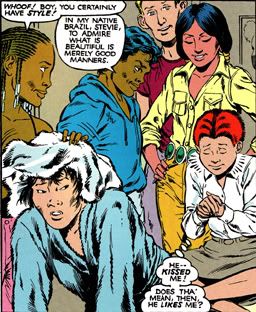

And, as apparent in this scene, her love for safari-wear in yellows and tans. It's during this phase in her education that she discovers Mutual of Omaha's Wild Kingdom and becomes a huge fan of Jim Fowler, Marlon Perkins' crack field operative. So much so that she even dresses like him during the team's downtime. Which they spend watching their dance teacher give Xi'an various haircuts.
Dani also displays a propensity for being captured, rendered unconscious, and then stripped and re-dressed. The first instance comes when she falls prey to the minions of Hydra. She'd been possessed by the spirit of... I don't know... some damn motorcycle riding gestalt thing, which leads to evil super-terrorist organization Hydra's interest in her. And their random changing of her clothes.


Weird outfit, indeed. It's a skintight green jumpsuit with yellow jackboots. It's identical to the one Madame Hydra or Lady Viper or whatever her name is wears in the story. Maybe it's some sort of weird "mother-daughter" bonding attempt on Madame Hy-Viper's part. She sees in Dani the daughter she never had but always wanted.
Unfortunately, the team is unable to save Xi'an, who apparently dies when the Hydra castle is blown to hell. They mourn Xi'an for... oh... about two days. Then it's off to Rio for the Carneval! Xi'an? Xi'an who?
Dani soothes her wounded heart by dressing like a Las Vegas showgirl. Possibly an extra in the 1995 Paul Verhoeven softcore sex-fest Showgirls:
To Dani, it's modest. At this point, it becomes increasingly clear that Dani is not only strong-willed and independent and has issues with authority... but she's also an exhibitionist. Not shy about her body is our Dani.
Nor is Dani shy about others' bodies, especially that of her Scottish burr-wielding li'l buddy, Rahne "Wolfsbane" Sinclair. Trekking through the Amazon rainforest, Dani shows a great deal of concern for Rahne's well-being and mode of dress. Solving Rahne's problems by rendering her naked, Dani happily removes her own clothes and jumps into the piranha-infested waters:
Soon after, the entire team is captured by anachronistic Roman soldiers and taken to Nova Roma... where again Dani is rendered unconscious and re-clothed:
Once Rahne shows off her wolf-transformative powers, though, the team becomes enshrined as semi-demi-gods and Dani gets to indulge herself fully in dressing and undressing. And being dressed and undressed. This, for Dani, is a little slice of heaven in the Andes. Even more so in that she gets to share it with the more demure Rahne.
Rahne also demonstrates her own burgeoning obsession with Dani's hair. But to be honest, everyone is obsessed with Dani's hair. It's lustrous and thick and looks like it belongs in a shampoo commercial. Just when Dani's beginning to enjoy herself, she's knocked out again and put into yet another outfit. This time it's slave girl bikini, one of Ghita of Alizarr's hand-me-downs. This sequence had a powerful effect on my 14-year-old self that I won't go into here:
Escaping Nova Roma, Dani finds she must now share the series lead with Chris Claremont's new underage writer's pet (latest in a long line that begins with Kitty Pryde and ends approximately with Jubilee), Colossus' little sister Illyana, who joins in issue #14 and immediately gets to narrate... an honor Claremont bestowed on her alone. Illyana is a kid who morphed into a teenager after spending several years in Limbo, an extra-dimensional otherworld.
Yep, this is where Claremont first demonstrates his gift for making shit as convoluted as possible. From this point, every X-character comes factory-equipped with multiple origins and extra-dimensional doppelgangers and future fates.
This is also where Claremont has teenagers throwing around words like "eldritch," which rarely appear outside of sword-and-sorcery pulp fiction or AD&D fan fiction.
While fighting the White Queen and her Hellions, Dani also ends up in yet another bizarre, skin-baring outfit. This time it's some kind of sexed up Native American warrior/stripper get-up complete with assless chaps and a breechcloth. Keep in mind that she's perhaps as young as 15, but certainly no more than 16 or 17 during this sequence.
Coming back to earth, Dani decides it's time to confront the demon bear that slew her parents. In order to do this, Dani must honor her Cheyenne ancestors by donning their traditional battle-wear- warpaint and a superhero costume.
This is actually a really cool look for her. With Bill Sienkiewicz on art, Claremont's writing takes a darker turn and the stories really come to life. Sienkiewicz combines Neal Adams with Ralph Steadman (sometimes he lays on the Steadman a little too thick, though) and fills the backgrounds and foregrounds with neat pop culture references, such as Alfred Hitchcock and Ben Casey cameos while Dani fights for her life.
Another cool look is Gunfighter Dani, courtesy Barry Windsor-Smith:
It's amazing what you get when you put good artists on a series.
After Sienkiewicz comes Steve Leialoha, who makes the figures cartoony and geometric, and then a brief run of Mary Wilshire with Sienkiewicz inking. With all the artist changes, the look is still more consistent than with Brett Blevins, who takes over pencils on the book for a lengthy and less-than-stellar run. While Blevins is actually an excellent artist, his angular and, frankly, ugly work on New Mutants is a downer. The characters are teenagers, yet they frequently look withered and aged, their faces full of meaningless lines and visual noise.
Especially Dani, who suddenly has a mountainous helmet of rock star hair.
They also rarely look like the same person on any given page, or even from panel to panel. Given his current work, Blevins' take on the Mutants is really shockingly bad. You're better off perusing his blog where he posts gorgeous life drawings and paintings. I should work harder at my own art so I can one day be half that good.
And once Claremont gives up the title in favor of Louise Simonson, Dani completes her transformation from hardnosed little rebel to complete Valley Girl fashionista, adopting the most "outrageous" of 80s fashions, perhaps in order to compete with Jem and the Holograms, or their rivals, the Misfits.
And her obsession with using Rahne as a couture test subject-- long simmering in the back of her mind on a low heat-- soon becames a flaming urge she's compelled to act upon lest it consume her.
Poor Rahne.
But not content with humiliating Rahne, Dani dons ripped-up workoutwear borrowed from "Let's Get Physical" era Olivia Newton-John and attacks Birdbrain, a hideous mutant animal-human hybrid the team briefly adopts.
At this point, the team's antics degenerate into self-parody and cutsy-pie "teenagers are so impulsive" John Hughes comedy bits. And somewhere in there, the team also receive their "graduation" uniforms:
There's an old saying: Keep it simple, stupid. Someone got a little mixed up and thought it was "Keep it simply stupid." Evidently, all the good ideas had been completely used up by the time the Mutants got their own personalized suits. These uniforms are so ugly and garish, they actually only rarely wear them, and only for punishment when they bomb a test or put a scratch on one of the school's fleet of sports cars.
This is another view of the suits, courtesy legendary artist John Byrne. We can't blame Byrne for this one; he was just going with the pile of shit they handed him. I really don't understand the aesthetic that's at work here. Random stripes? Cyclops had already cornered the market on yellow, so Sam's forced to go with pumpkin orange? And Dani's wearing boots she copped from Belinda Carlisle around the time "Circle in the Sand" hit big.
But the Mutants and their fashion disaster ways could defeat any artist. Even the normally brilliant Alan Davis tries to make them look individualistic and cool and fails miserably.
Purple, red, pink and orange. The colors of ass, 80's style.
Feeling discontented with the winds of change blowing, Dani attacks Birdbrain again. At least she's giving poor Rahne a break.
But Dani's worst look is the one she adopts on her final trip to Asgard. Fairly early in the series, Claremont thought it'd be a great idea to make Dani into a Valkyrie. I know what you're thinking, Dani's Native American, the Valkyrie are some sort of Scandinavian myth, it's a natural and totally non-forced combination. Unfortunately, this just adds yet another level of convoluted nonsense onto a character who was quickly picking up a lot of this kind of continuity dryer lint... much like EVERY X-character at the time.
Eventually, Louise Simonson must've just gotten sick of it and decided to write Dani out of the series. The end result is a flaming red Dani showing signs of emaciation that would give Nichole Richie pause:
Skeletor Dani rides again!
Being a smart cookie, Dani decides to stay in Asgard with her Valkyrie friends as Rob Liefeld (famous for drawing comics with a pencil actually shoved up his rectum) inherits the art chores with issue #87. It's a shrewd move, because pretty soon the old stand-by characters are shouldered out by freakishly pinheaded monstrosities with names like "Cable" and "Rictor" and "Assmodio, the Assular Ass Boy."
Too good a character to stay in Asgardian narrative purgatory forever, Dani makes a return to the Marvel Universe, only to have several more layers of unnecessary backstory painfully grafted onto her. She's a mutant terrorist, she's undercover, she has new powers that have nothing to do with her original ones.
But as her outfit reveals, one thing about Dani remains consistent: she still loves being naked or nearly naked. Our mutant exhibitionist. Now depowered, but still kicking it, Dani-style.
My beloved Dani Moonstar. Tomboy. Rebel. Leader. Self-doubter. Frequently naked. Other than the naked part, I immediately identified with her from her first appearance. We had the same anti-authoritarian tendencies, the same fiercely independent, willful "do it your own way and possibly die trying" streak and we both suffered similar bouts of near-crippling doubt. But it's hard not to like Dani because the writers- Claremont and Simonson- always seem to make her the center of attention. From the early "crazy Dani" Brood storyline, to the "Demon Bear Saga," up to her Asgardian swan song, Dani dominates.
I still think a road trippin' mini- or continuing series with Dani and Xi'an driving around the country in a Chevy conversion van, helping people here and there and frequently skinnydipping would be a hoot. Especially if they dragged Rahne around with them. I'd buy it. Possibly I'm the only one.
Oh, here's an image where she actually is naked:
Looks like she finally got to make that shampoo commercial! Rahne TIVO'd it. Actually, she made two of them:
So there you have her in a nutshell, Dani Moonstar. Let's let Dani herself have the last word, as she ably sums up her personal philosophy to her reluctant protege, Rahne Sinclair:
That's right, baby! Keep flaunting it!


